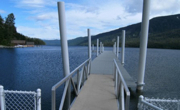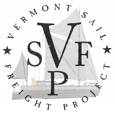 How a group of farmers, high school students, and community Imagine boarding a flat-bottomed sailing barge for a 300-mile voyage from the shores of Lake Champlain to New York harbor. The hold is laden with twelve tons of locally produced wheat, flour, dry beans, maple syrup, apples, cabbages, and hard cider. This is not a historic re-enactment. This is the future! The Vermont Sail Freight Project is a community initiative to raise the profile of small-scale farmers and demonstrate carbon neutral regional freight transport. The voyage just described is slated to take place in the fall of 2013. It's the product of a joint effort of farmers, educators, high school students, artists, artisans, and woodworkers, through all-volunteer labor at the community level.  The Vermont Sail Freight Project's trade route
In my town, cooperation among farmers and the involvement of the whole community in the life of farms used to be part of the culture. It was also an underpinning of economic security and community prosperity during good times, and survival in bad. A neighbor of mine described how his late uncle once told him the Great Depression left barely a mark on life on their Ferrisburgh farm, since nearly all important needs could still be met somehow within the community. Some people still picture Vermont in this light, as an agrarian idyll. Now, I can tell you firsthand that this communitarian approach to farming and life is not dead, but it's not quite as alive and well as you might imagine. An extractive, industrial, expansionist approach to farming, the one that says “get big or get out” dominates the landscape. Our farming and cultural future hangs in the balance.
What kind of future do we want for rural New England? One vision is one in which large scale dairy
I have a 2013 calendar with illustrations of barns in central New York State. The illustrations,
The story the calendar does not tell through its beautiful pencil drawings is that people Maybe the future for the culture lies not in More and Bigger, but in small places, and in work that's grounded by the relationships between neighbors and the fact that our natural environment is not replaceable. There is no greater calling for a farmer than to safeguard and steward the working landscape for the next generation. Sometimes we farmers who think this way are hard to notice, especially at a regional level, because most of us are preoccupied with the minutiae of our work, work which of course usually succeeds or fails depending on its worth to the immediate community. Being visible as a group, and conveying the value of our work and our individual stories as farmers beyond the confines of the county line is usually a low priority. Understandably, I suppose. We're plenty busy!
The Vermont Sail Freight Project is a way to amplify the message of this cultural shift, and at the same time restore a historic trade route that at one time formed a bond between our populous seacoast and food-producing inland New England. The work being done by a new generation of small scale farmers is important: we need to make the value of our work known by bringing our goods and our stories by Why a sailboat?
Long before I settled down to farm in Vermont, I wanted to learn to build wooden boats, and worked one summer at a boatbuilding school in Maine at the age of 19. The boats that were produced there were masterful works of craftsmanship, but I became quickly disillusioned by the fact that although the vessels were derived from traditional forms, the only utility they had in the present-day world was for Since that seemed impossible, I went on to house carpentry, furniture, and finally to rice farming. But I have always wanted to build a boat to do real work. The desire to do that somehow would never quite leave me alone. After settling down to farm in Vermont, I came up with the Vermont Sail Freight Project as a way to link the causes of the agrarian rebirth I was witnessing around me with carbon-neutral transportation based on an historic regional trade route. Starting about two years ago I began to research the approach to the project. It was important to me that the project be community-driven and amateur-friendly. The boat would be carrying cargo, but also a message: “We, the people of the Champlain Valley, have done this thing ourselves.”
This is not to say that our design could not benefit from all the study and expertise we could bring to it, and I am grateful for the input of several very seasoned hands in naval architecture and plywood 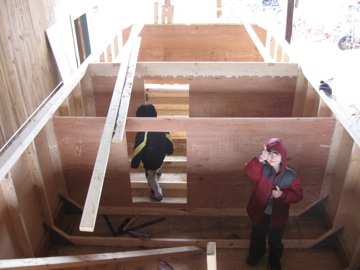 Robin Andrus (Age 5) stands on the bow of Ceres
From the very early days of the project, people with whom I shared the idea were almost universally taken with it. There is real and useful work here, and also symbolism. There is also the suggestion that a slower, more local way of living may involve some real improvements in the quality of life, giving up the monotony of driving a semi on the interstate for the subtle joy of manipulating a boat with a life and spirit of its own in wind and tide. Over time I began to feel that this had the potential to become more than my personal pipe dream, but that it was something that would rally the whole community, and could potentially transform our way of thinking about food systems on a regional scale, and give the goods and the stories of our farmers a visible presence in a crowded and competitive marketplace. By crowd-sourcing much of our funding (through Kickstarter) and relying entirely on unpaid volunteer labor, we are bringing this about from the grassroots. In fact it's possible that the project is so far beyond the pale of normal business and economic-development thinking that there might be no other way to do it! Without considering the character of the participating farmers, their goods, their communities, the waterway, the design, the builders, and the markets with a systems-thinking approach, any one aspect considered in isolation would probably provide a very incomplete model. 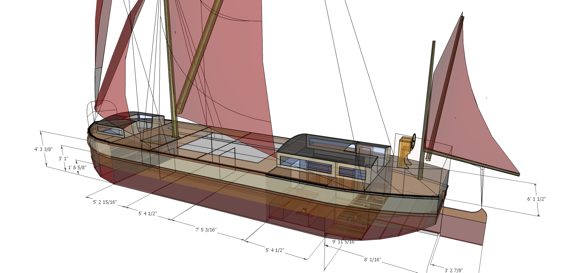 Ceres has three cargo holds and has a cargo capacity of about 13 tons. She draws less than 2 feet fully laden, has a hinged mast to pass under low bridges, and an integral sprit crane for handling bulk cargo.
But a complex but compelling idea also needs a forward-thinking core group to carry it out. In Monkton Vermont (the next town over from where I farm) is the Willowell Foundation, a non-profit that offers an alternative senior year of high school to the local school district. The kids in that program learn in an outdoor classroom, quite literally around a campfire even in winter snow, with an emphasis on agriculture and environmental education. Matt Schlein, Executive Director of Willowell, and Hannah Mueller, Associate Director, partnered with me in October 2012 to pull off the Vermont Sail Freight Project, and have been creative and invaluable partners who share my sense of investment in the community. Willowell provides a structure for participating senior-high schoolers to help construct our sailing barge and to have a role in making the vision a reality, and for welcoming the contributions of talented artists, musicians, and woodworkers to lend beauty, wit, and sincerity to the overall effort. When I first was getting ready to buy a piece of land and begin farming, I sat down at a meeting with a University of Vermont extension agent. This fellow had spent most of his career working with the kind of large scale dairy farms that still take up most of the working land in the Champlain Valley. I wanted help formulating a plan to grow crops like wheat or to produce grass-fed beef for local markets. This agent then patiently explained why none of my ideas would work and that I would go broke if I did anything except large-scale dairy. 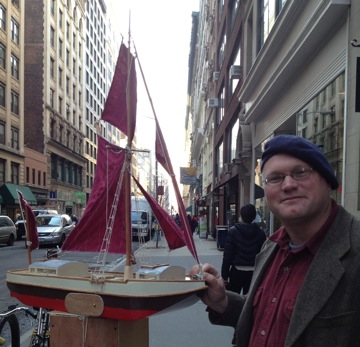 Project Director Erik Andrus with the 1/12th scale model of Ceres
I didn't buy that particular farm but went on to produce grains and beef in exactly the way that I was told would never work. I wouldn't go so far as to say that we have been an outrageous business success, but now we are making a go of it. Not making a killing, mind you, but making a living. I'm not alone in this. We contrary farmers and contrary-farmer-sympathizers are growing in number. While economists and experts say that this or that is uneconomical, non-viable, impractical, whatever, we shake our heads and go and do it anyway. Not just to be obstinate (though I do confess I take a little pleasure in obstinacy) but also because we simply need to, and we know the inherent value of the work we do, for ourselves and our future even though the way forward might not be easy. In so doing we're rebuilding a culture that can use tools old and new to address the challenges we face as a people, a culture in which beauty and integrity matter more than ever, and where the natural world and the quality of our communities matter much more than our machines. * * * * *
Erik Andrus, member of the Sail Transport Network, can be reached at erik@vermontsailfreightproject.org  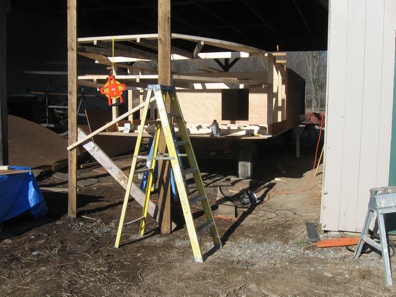 |
|||
 |
||
|
|
